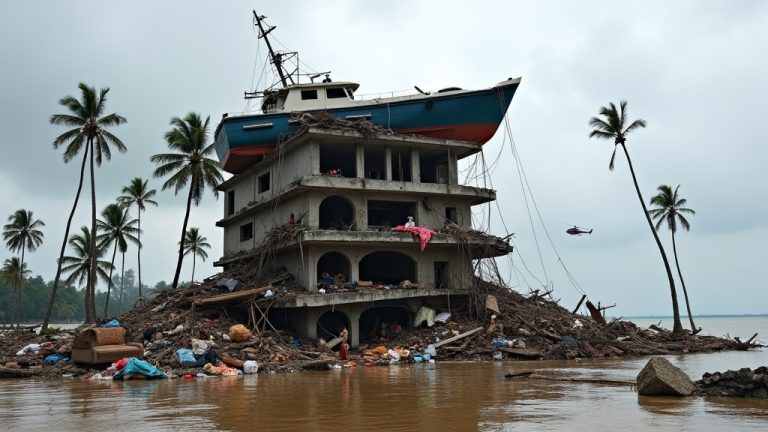The Great Kantō earthquake struck Japan’s capital region on September 1, 1923, releasing a devastating 7.9 magnitude shock that triggered both a 40-foot tsunami and catastrophic fires.
The 14-second quake, followed by intense aftershocks, toppled buildings across Tokyo and Yokohama, while ruptured water mains left firefighters helpless against wind-driven flames that consumed half the capital. Over 140,000 people perished in this triple disaster, which would fundamentally reshape Japan’s approach to urban planning and disaster preparedness.
The Fatal Day: September 1, 1923
In a single devastating moment at 11:58 a.m. on September 1, 1923, the Kantō region of Japan experienced one of history’s most catastrophic natural disasters when a massive earthquake erupted from deep beneath Sagami Bay.
The initial shock, which emanated from a fault six miles below the surface and roughly 30-40 miles southwest of Tokyo, registered between 7.9 and 8.3 on the Richter scale and lasted just over 14 seconds. Across the region, brick and unreinforced concrete buildings immediately crumbled under the intense seismic forces.
Within minutes, a massive tsunami with waves reaching heights of 33-40 feet slammed into the coastal areas along Sagami Bay, destroying countless structures and sweeping away thousands of people.
In Atami City alone, the rushing waters demolished 155 houses and claimed numerous lives. The earthquake and subsequent devastation resulted in a monumental death toll over 140,000.
Seismic Forces and Ground Zero
The seismic activity originated six miles beneath Sagami Bay‘s floor, approximately 50 miles southeast of Tokyo, with violent shaking that persisted for five minutes.
The earthquake’s impact proved particularly devastating in Tokyo’s poorer neighborhoods, where unstable soil conditions east of the Sumida River led to widespread structural collapse.
A subsequent tsunami, reaching heights of up to 40 feet, wreaked havoc along the coastal areas.
The region’s geological history had forewarned of such an event, as seismologist Akitune Imamura had predicted a major earthquake would occur in this seismic gap zone, which typically experienced significant activity every seventy years.
The initial earthquake, triggered by the collision of the Philippine oceanic plate with the Eurasian continental plate, struck at 11:58 a.m. and lasted for fourteen terrifying seconds.
The Deadly Dance of Fire and Water
Devastating fires erupted across Tokyo and Yokohama within minutes of the initial tremors, marking the beginning of what would become the earthquake’s deadliest aftermath.
High winds fanned the flames through neighborhoods filled with wooden structures, while destroyed water mains left firefighters helpless to combat the inferno.
The combination proved catastrophic, with the fires ultimately consuming over half of Tokyo and nearly all of Yokohama.
Thousands who sought refuge near the Sumida River perished in the flames, while coastal communities faced nature’s fury from both land and sea, creating an insane disaster that would reshape Japan’s approach to urban planning and disaster prevention.
Human Cost and Survival Stories
Human suffering reached staggering proportions, with estimated fatalities ranging between 105,000 and 142,000 people.
Nearly half of these deaths occurred during the initial quake, while devastating fires claimed roughly 90% of lives lost in Tokyo’s metropolitan region, affecting over half the city’s population.
As buildings collapsed and flames spread, survivors fled to parks and riverbanks, establishing makeshift shelters while communities banded together despite widespread infrastructure damage.
Over 2000 firsthand accounts from children documented their experiences of survival and loss during the catastrophe.
The disaster’s psychological impact would persist for generations, though it ultimately led to improved urban planning and disaster preparedness throughout Japan.
Emergency Response and Relief Efforts
The earthquake’s timing on a Saturday afternoon proved particularly problematic, as government employees had already departed for the weekend, leaving critical response mechanisms understaffed and poorly coordinated.
The military emerged as the primary responder, with the establishment of the Kanto Martial Law Enforcement Headquarters on September 3 mobilizing 50,000 Imperial Japanese Army troops.
These forces constructed 74 temporary bridges, cleared 130 miles of roads, and established relief camps that would eventually shelter over 105,000 refugees.
Meanwhile, private corporations and municipal facilities accommodated an additional 20,000 displaced residents, while temporary medical facilities provided essential care for the injured.
The quick formation of a new Cabinet under Yamamoto on September 2nd demonstrated the government’s commitment to addressing the crisis, despite initial coordination difficulties.
Rebuilding From the Ashes
Under the leadership of Shinpei Goto, who was appointed president of the Bureau for Reconstruction, officials developed extensive plans to transform the ravaged city into a modern capital.
The scale of reconstruction was amazing, with workers clearing debris from 33 million square meters of destroyed buildings while implementing new infrastructure projects across fire-damaged areas.
Though Goto’s initial 1.5 billion yen budget faced severe cuts to 468.44 million yen, the reconstruction efforts pressed forward, introducing modern city planning methods that included improved roads, bridges, and parks.
The government claimed 10% of property from landowners without compensation to create space for public infrastructure and social welfare facilities.
These fundamental changes would later influence Tokyo’s post-World War II development, establishing lasting patterns in urban design and disaster preparedness.
References
- https://www.britannica.com/event/Tokyo-Yokohama-earthquake-of-1923
- https://www.asianstudies.org/publications/eaa/archives/the-great-kanto-earthquake-of-1923-and-the-japanese-nation/
- https://library.brown.edu/cds/kanto/ksmith.html
- https://www.seismosoc.org/news/largest-historic-fire-death-toll-belongs-to-aftermath-of-1923-japan-earthquake/
- https://www.ebsco.com/research-starters/earth-and-atmospheric-sciences/great-kwanto-earthquake
- https://www.smithsonianmag.com/history/the-great-japan-earthquake-of-1923-1764539/
- https://www.nibs.org/blog/100-years-inspiration-japans-1923-earthquake
- https://en.wikipedia.org/wiki/1923_Great_Kantō_earthquake
- https://www.swissre.com/institute/research/sigma-research/Economic-Insights/100-year-legacy-japan-great-kanto-earthquake.html
- https://www.ngdc.noaa.gov/hazel/view/hazards/earthquake/event-more-info/3227




